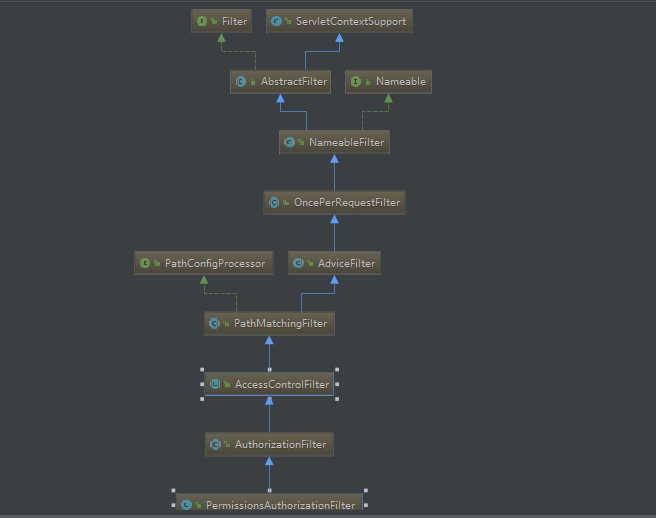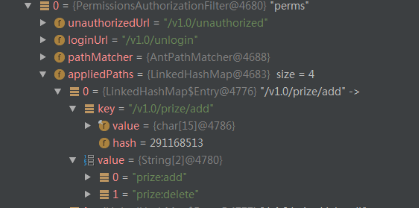前言
前面两篇文章主要讲了SpringShiroFilter的初始化以及doFilter方法。总结一下:初始化的主要操作是根据配置构建所有url对应的过滤链,doFilter()方法将url对应的过滤链添加到javaEE原生的的过滤器中。
本篇文章的内容
本篇文章主要解析具体的Filter是如何处理鉴权的(即如何判断某个用户是否有权限访问该url)。本篇文章一PermissionsAuthorizationFilter为例(shiro默认的拦截器有9个,包括roles,anno,perms等等)
正文
首先给出PermissionsAuthorizationFilter的类结构,该类只有一个isAccessAllowed方法

public class PermissionsAuthorizationFilter extends AuthorizationFilter {
//TODO - complete JavaDoc
public boolean isAccessAllowed(ServletRequest request, ServletResponse response, Object mappedValue) throws IOException {
Subject subject = getSubject(request, response);
String[] perms = (String[]) mappedValue;
boolean isPermitted = true;
if (perms != null && perms.length > 0) {
if (perms.length == 1) {
if (!subject.isPermitted(perms[0])) {
isPermitted = false;
}
} else {
if (!subject.isPermittedAll(perms)) {
isPermitted = false;
}
}
}
return isPermitted;
}
}
第一步,既然是过滤器,我们当然还是一步一步往上寻找doFilter()方法,最终还是在OncePerRequestFilter()方法中找到
public final void doFilter(ServletRequest request, ServletResponse response, FilterChain filterChain)
throws ServletException, IOException {
String alreadyFilteredAttributeName = getAlreadyFilteredAttributeName();
if ( request.getAttribute(alreadyFilteredAttributeName) != null ) {
log.trace("Filter '{}' already executed. Proceeding without invoking this filter.", getName());
filterChain.doFilter(request, response);
} else //noinspection deprecation
if (/* added in 1.2: */ !isEnabled(request, response) ||
/* retain backwards compatibility: */ shouldNotFilter(request) ) {
log.debug("Filter '{}' is not enabled for the current request. Proceeding without invoking this filter.",
getName());
filterChain.doFilter(request, response);
} else {
// Do invoke this filter...
log.trace("Filter '{}' not yet executed. Executing now.", getName());
request.setAttribute(alreadyFilteredAttributeName, Boolean.TRUE);
try {
doFilterInternal(request, response, filterChain);
} finally {
// Once the request has finished, we're done and we don't
// need to mark as 'already filtered' any more.
request.removeAttribute(alreadyFilteredAttributeName);
}
}
}
public void doFilterInternal(ServletRequest request, ServletResponse response, FilterChain chain)
throws ServletException, IOException {
Exception exception = null;
try {
boolean continueChain = preHandle(request, response);
if (log.isTraceEnabled()) {
log.trace("Invoked preHandle method. Continuing chain?: [" + continueChain + "]");
}
if (continueChain) {
executeChain(request, response, chain);
}
postHandle(request, response);
if (log.isTraceEnabled()) {
log.trace("Successfully invoked postHandle method");
}
} catch (Exception e) {
exception = e;
} finally {
cleanup(request, response, exception);
}
}
这里鉴权的核心在于doFilterInternal方法中的boolean continueChain = preHandle(request, response),如果鉴权通过则返回true,并且调用executeChain()调用下一个过滤器。(这里我找了好一番时间才发现鉴权逻辑躲在preHandle里面,抓狂,正常理解不怎么都应该在executeChain里面嘛。暗暗吐槽)
下面让我们来一层一层的剥开preHandle的外衣。
protected boolean preHandle(ServletRequest request, ServletResponse response) throws Exception {
if (this.appliedPaths == null || this.appliedPaths.isEmpty()) {
if (log.isTraceEnabled()) {
log.trace("appliedPaths property is null or empty. This Filter will passthrough immediately.");
}
return true;
}
for (String path : this.appliedPaths.keySet()) {
// If the path does match, then pass on to the subclass implementation for specific checks
//(first match 'wins'):
if (pathsMatch(path, request)) {
log.trace("Current requestURI matches pattern '{}'. Determining filter chain execution...", path);
Object config = this.appliedPaths.get(path);
return isFilterChainContinued(request, response, path, config);
}
}
//no path matched, allow the request to go through:
return true;
}
第一步检查appliedPaths是否为空,这里可能有小伙伴忘记appliedPaths里面存的是什么了,还是得祭出第一篇文章的dubug图。

for (String path : this.appliedPaths.keySet()) {
// If the path does match, then pass on to the subclass implementation for specific checks
//(first match 'wins'):
if (pathsMatch(path, request)) {
log.trace("Current requestURI matches pattern '{}'. Determining filter chain execution...", path);
Object config = this.appliedPaths.get(path);
return isFilterChainContinued(request, response, path, config);
}
}
这里得到了权限配置的config,这里的config对象通过debug图可看到是一个String数组,这都是在第一篇文章Filter初始化时完成的,其实里面就是我们配置的权限,例如perms[user:add,user:delete]。第三步调用isFilterChainContinued()进行鉴权
private boolean isFilterChainContinued(ServletRequest request, ServletResponse response,
String path, Object pathConfig) throws Exception {
if (isEnabled(request, response, path, pathConfig)) {
return onPreHandle(request, response, pathConfig);
}
return true;
}
点开onPreHandle,注意这里是个逻辑表达式,如果前面isAccessAllowed()返回true,后面的OnAccessDenied()方法将不会执行。(短路原则)
public boolean onPreHandle(ServletRequest request, ServletResponse response, Object mappedValue) throws Exception {
return isAccessAllowed(request, response, mappedValue) || onAccessDenied(request, response, mappedValue);
}
最终调用到我们PermissionsAuthorizationFilter的isAccessAllowed方法。getSubject得到用户,将鉴权的逻辑委派给Subject。(Subject在SpringShiroFilter中创建了,所以这里可以直接获取到,如何创建以及维护的在后面的文章讲解)
public boolean isAccessAllowed(ServletRequest request, ServletResponse response, Object mappedValue) throws IOException {
Subject subject = getSubject(request, response);
String[] perms = (String[]) mappedValue;
boolean isPermitted = true;
if (perms != null && perms.length > 0) {
if (perms.length == 1) {
if (!subject.isPermitted(perms[0])) {
isPermitted = false;
}
} else {
if (!subject.isPermittedAll(perms)) {
isPermitted = false;
}
}
}
return isPermitted;
}
这里首先判断有没有principals(凭证,登录时放进去的,权限是通过凭证获取的,也是识别用户的唯一标识,一般为用户名)。如果有凭证则将鉴权委托给securityManager。(shiro官网也提及到securityManager是shiro的核心,到后面会发现所有的登录,鉴权,session管理都是由它掌控的)
public boolean isPermittedAll(String... permissions) {
return hasPrincipals() && securityManager.isPermittedAll(getPrincipals(), permissions);
}
这里稍微看一下securityManager的类图结构,方便以后章节的讲解。authenticator处理登录,authorizer处理鉴权,sessionManager处理sesison管理

本篇文章涉及到的是authorizer,回头看到我们的spring-shiro.xml配置文件,我配置的是一个多认证器,并为他设置了认证策略(一个成功为成功)。

public boolean isPermittedAll(PrincipalCollection principals, String... permissions) {
assertRealmsConfigured();
if (permissions != null && permissions.length > 0) {
for (String perm : permissions) {
if (!isPermitted(principals, perm)) {
return false;
}
}
}
return true;
}
public boolean isPermitted(PrincipalCollection principals, Permission permission) {
assertRealmsConfigured();
for (Realm realm : getRealms()) {
if (!(realm instanceof Authorizer)) continue;
if (((Authorizer) realm).isPermitted(principals, permission)) {
return true;
}
}
return false;
}
public boolean isPermitted(PrincipalCollection principals, String permission) {
Permission p = getPermissionResolver().resolvePermission(permission);
return isPermitted(principals, p);
}
这里将权限字符串构建成了一个permission对象,这个permission对象可以执行通配符式的权限比对。然后开始获取AuthorizationInfo(授权信息)
public boolean isPermitted(PrincipalCollection principals, Permission permission) {
AuthorizationInfo info = getAuthorizationInfo(principals);
return isPermitted(permission, info);
}
注意这个getAuthorizationInfo先从缓存中获取(所以shiro是支持授权缓存的),如果缓存为空才调用doGetAuthorizationInfo获取授权。
protected AuthorizationInfo getAuthorizationInfo(PrincipalCollection principals) {
if (principals == null) {
return null;
}
AuthorizationInfo info = null;
if (log.isTraceEnabled()) {
log.trace("Retrieving AuthorizationInfo for principals [" + principals + "]");
}
Cache<Object, AuthorizationInfo> cache = getAvailableAuthorizationCache();
if (cache != null) {
if (log.isTraceEnabled()) {
log.trace("Attempting to retrieve the AuthorizationInfo from cache.");
}
Object key = getAuthorizationCacheKey(principals);
info = cache.get(key);
if (log.isTraceEnabled()) {
if (info == null) {
log.trace("No AuthorizationInfo found in cache for principals [" + principals + "]");
} else {
log.trace("AuthorizationInfo found in cache for principals [" + principals + "]");
}
}
}
if (info == null) {
// Call template method if the info was not found in a cache
info = doGetAuthorizationInfo(principals);
// If the info is not null and the cache has been created, then cache the authorization info.
if (info != null && cache != null) {
if (log.isTraceEnabled()) {
log.trace("Caching authorization info for principals: [" + principals + "].");
}
Object key = getAuthorizationCacheKey(principals);
cache.put(key, info);
}
}
return info;
}
doGetAuthorizationInfo最终会调用到我们的配置的Realms类的,实现我们自己的授权逻辑
/**
* 授权,会在需要验证权限的时候被shiro调用,如果开启了缓存则只会第一次验证的时候被调用.
*
* @param principals
* @return AuthorizationInfo
* @author liuruojing
* @since ${PROJECT_NAME} 0.1.0
*/
@Override
protected final AuthorizationInfo doGetAuthorizationInfo(final PrincipalCollection principals) {
String username = (String) principals.getPrimaryPrincipal();
User user = userMapper.selectByUsername(username);
Set<String> roles = new HashSet<>(); //角色集合
Set<String> permissions = new HashSet<>(); //权限集合
//根据userId查出所拥有的roleId
List<Long> roleIds = userRoleMapper.selectByUserId(user.getUserId());
Iterator<Long> iterator = roleIds.iterator();
while (iterator.hasNext()) {
Long roleId = iterator.next();
Role role = roleMapper.selectByPrimaryKey(roleId);
//将角色放入角色集合
roles.add(role.getRoleName());
//根据角色查出权限Id
List<Long> permissionIds = rolePermissionMapper.selectByRoleId(roleId);
Iterator<Long> pIterator = permissionIds.iterator();
while (pIterator.hasNext()) {
Long permissionId = (Long) pIterator.next();
Permission permission = permissionMapper.selectByPrimaryKey(permissionId);
//将所有权限放入权限集合
permissions.add(permission.getPermissionName());
}
}
SimpleAuthorizationInfo info = new SimpleAuthorizationInfo();
info.setRoles(roles); //放入角色
info.setStringPermissions(permissions); //放入权限
return info;
}
}
现在我们知道了访问url需要的权限,同时也查询出了此用户具有的权限,我们只需要进行比对两者便可以知道用户是否有权限访问此url了。将获取的AuthorizationInfo解析成Permission对象集合,逐个调用Permission对象的implies方法进行比对。如果比对成功则返回true执行下一个所需权限的比对。
//changed visibility from private to protected for SHIRO-332
protected boolean isPermitted(Permission permission, AuthorizationInfo info) {
Collection<Permission> perms = getPermissions(info);
if (perms != null && !perms.isEmpty()) {
for (Permission perm : perms) {
if (perm.implies(permission)) {
return true;
}
}
}
return false;
}
最后所有权限比对完后会回到上面的onpreHandle(),如果isAccessAllowed鉴权通过则返回true,否则调用onAccessDenied方法设置重定向到unloginUrl或者unAuthorizedUrl,这两个url是我们在xml中配置的
public boolean onPreHandle(ServletRequest request, ServletResponse response, Object mappedValue) throws Exception {
return isAccessAllowed(request, response, mappedValue) || onAccessDenied(request, response, mappedValue);
}
protected boolean onAccessDenied(ServletRequest request, ServletResponse response) throws IOException {
Subject subject = getSubject(request, response);
// If the subject isn't identified, redirect to login URL
if (subject.getPrincipal() == null) {
saveRequestAndRedirectToLogin(request, response);
} else {
// If subject is known but not authorized, redirect to the unauthorized URL if there is one
// If no unauthorized URL is specified, just return an unauthorized HTTP status code
String unauthorizedUrl = getUnauthorizedUrl();
//SHIRO-142 - ensure that redirect _or_ error code occurs - both cannot happen due to response commit:
if (StringUtils.hasText(unauthorizedUrl)) {
WebUtils.issueRedirect(request, response, unauthorizedUrl);
} else {
WebUtils.toHttp(response).sendError(HttpServletResponse.SC_UNAUTHORIZED);
}
}
return false;
}